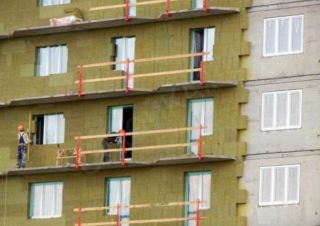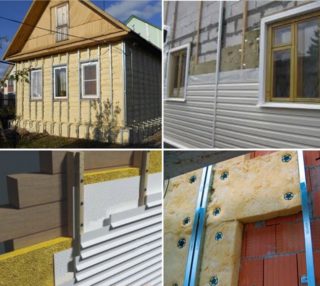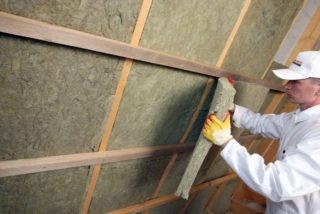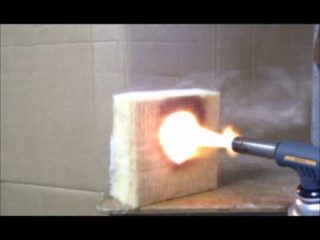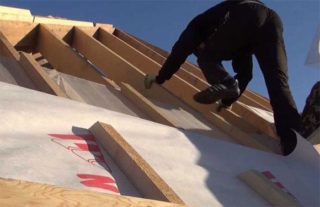Building insulation Izba provides the quality of thermal energy conservation in residential, office buildings, shops and industrial premises. Due to the characteristics of production (miniplate and synthetic binder), the material is environmentally friendly. This combination of components provides effective thermal insulation and a comfortable temperature in any room.
Features of the production of insulation Izba
Mineral wool insulation is characterized by minimal hygroscopicity and good density. For this reason, basalt, gabbro rocks, hydrophobic additives and a synthetic binder are used to produce the Izba insulator. The insulation based on basalt fibers was developed in the Russian Federation, therefore it is fully adapted to the domestic climate.
Production is concentrated on the territory of Russia, in the Sverdlovsk region, which eliminates the overpayment of the client for customs declarations of conformity and transportation.
The technical manufacturing process is worth considering in stages:
- Extraction of basalt in quarries and its transportation to the plant for further processing.
- Crushing large pieces into small fractions.
- Melting material. The crushed basalt is heated red-hot, and then cooled with an air stream under pressure. The density of the plate depends on the pressure altitude parameters.
- The formation of cotton wool with short fibers from a viscous mass.
- Plate forming. The quality of the adherence of the fibers to each other is controlled, special substances are used for tight bonding.
Due to the dense interwoven base, the cotton wool is resistant to tensile forces. The entangled structure helps prevent sound exposure. The insulation is not afraid of mechanical influences, but it is cut without any problems.
The final product in the form of plates is delivered in packages of 4-8 pieces. Minvata Izba of a plate type is easily cut into stripes, square and rectangular elements, which eliminates overruns.
The manufacturer selects the optimal proportions of basalt and auxiliary components, so the products are environmentally friendly.
The name of the product is an abbreviation of the words Isolation Basalt.
Varieties of insulation Izba
The manufacturer produces several series of heaters, which vary in density, thickness and scope of use.
Hut Facade
Thermal insulation of the Facade line is distinguished by noise-proofing properties, it is laid on the external surfaces of buildings up to 16 m high. It is compatible with plaster and ceramic tile lining.
The facade line includes the series:
- MS - lightweight material with a density of 95 to 105 kg / m3 for low-rise buildings.
- BC - with density parameters from 105 to 125 kg / m3 and thermal conductivity of 0.036-0.043 W / m · K.
- 135 - slabs for plaster without reinforcement.
- 150 - with a coefficient of thermal conductivity of 0.037-0.046 W / m · K.
The insulation of the hut is cut into strips in order to perform fire-prevention dissipations or external laying along the line of windows and doors.
Izba Light
The miniplate is used for structures that are not affected by the load. Using the material, you can warm the attic, floor or walls of a private house, cottage, industrial workshop. Non-combustible heat-insulating boards have dimensions of 100x60 cm and are 50-200 mm in thickness.Depending on the series, the hydrophobized material differs:
- density from 32 to 42 kg / m3;
- thermal conductivity of 0.035 W;
- vapor permeability of 0.3 mg / Pa;
- moisture absorption from 1 to 1.5%.
The slab from the Light series is suitable for laying on pitched roofs, attics, floor floors, between floor logs.
Hut Vent
Mineral-cotton insulated for installation on ventilated facades. Density parameters make it possible to form several layers with a total thickness of 8-9 cm. The series is distinguished by increased sound insulation and fire resistance, it is represented by several options depending on the density:
- 25 kg / m3 - mats that are light and friable;
- 30 kg / m3 - absorbs 3% moisture when completely immersed, therefore it needs additional hydro and vapor barrier;
- 35 kg / m3 - water absorption is 2.5%, compression is 20%;
- 40 kg / m3 - suitable for insulation of floors and interior structures.
The heater is mounted without a windproof film.
Hut Roofing
The roof with this series is insulated in two layers. Minvata is represented by three categories:
- for the top - slabs with parameters density 175-190 kg / m3 and thermal conductivity from 60 to 70 kPa;
- for the bottom - the density is from 100 to 110 kg / m3, and the stiffness allows you to withstand the top layer;
- for screeds or roll waterproofing - the density of the material ranges from 135 to 150 kg / m3.
The hut of the Roofing series is suitable for flooring and floor beams.
Hut Standard
The manufacturer's insulation Izba Standard Series is represented by several models:
- Medium hardness. The density of the slabs is 60 or 70 kg / m3, which allows them to be used for attics, walls inside and outside, of an inclined roof.
- Lungs. Materials with a density of 40 or 50 kg / m3 are used for interior partitions, lightweight layer of curtain wall systems.
The series is characterized by thermal conductivity of 0.035-0.038 W / m · K, compression density from 6 to 12% and water absorption of 1.5%.
Thermal insulation thickness Standard - from 50 to 200 mm.
Advantages and disadvantages
The advantages of mineral wool manufacturer Izba include:
- minimum level of thermal conductivity - the dense material holds heat well even with severe cooling;
- vapor permeability of the coating - walls with insulation “breathe”, therefore they are not destroyed;
- environmental safety - toxic substances are not emitted during installation and operation;
- resistance to fires - stone wool is classified as non-combustible material;
- low hygroscopicity - moisture-resistant boards can be installed outside the house and in wet rooms;
- lack of crumbs and waste when cutting;
- density, providing sound insulation even of a thin wall;
- simplicity of laying and processing with the help of cutting;
- resistance to chemicals, damage by rodents and insects, the formation of mold and fungus.
The disadvantages of the heat insulator include fragility, which leads to damage as a result of transportation and installation. A basalt slab weighs more than other mineral insulators.
Operation specifics
Minplita is delivered in branded plastic packaging TM Izba. Shrink film provides long-term storage in an indoor environment. A universal heat insulator is used to perform thermal protection:
- bearing wall surfaces;
- roofing structures;
- attic rooms;
- floor and ceiling ceilings;
- internal partitions;
- window and door openings;
- ventilation and heating lines.
Mineral plates can be used as noise protection.
Rules for the installation of insulation Izba
It is allowed to install the isolate on the frame, horizontally or slope. For frame insulation, fasteners are not used - the plates enter the cell with an interference fit. When insulating work on the ceiling, frame suspensions are used, and the material is mounted on dowels. On the pitched roof, rafters or a counter-lattice are assigned for fasteners.
The specifics of installing thermal insulation depends on the type of work, but there are several general rules:
- Before work, the surface and the wool itself are inspected for defects.
- Together with the vapor barrier, the slab is laid on the roof with an air gap of 5 cm. To eliminate the risks of moisture, the joints are glued with tape.
- When mounting on the floor, a membrane waterproofing is placed before the insulation.
- On a wooden frame with antiseptic impregnation, vertical racks are pre-stuffed. The thickness of the plates is selected depending on the thickness of the timber.
- Cross beams are adapted to the size of mineral wool. The insulator should go into the finished cell tightly, fully adhering to the frame. This prevents the formation of "cold bridges."
- A vapor barrier film is laid on the finished material, and then sheets of drywall, OSB, and chipboard are laid.
- It is allowed to make wind-sheathing on the outer wall, and only then - lay the material.
The insulation can be laid in 2-3 layers.
Comparison of insulation Izba and Rocklight
TM Izba basalt cotton wool is popular among private developers and large companies. To understand this process, it makes sense to compare it with another thermal insulation. For example, take the basalt analogue of TM Technonikol.
Rocklayt stone wool is suitable for sloping roofs, siding, as mounted vertically, horizontally and obliquely on a special frame. The thermal conductivity of the material is constant - 0.036 W / m, the density is 30 kg / m3, which is lower than that of the Izba. Minvata does not shrink, but it must be used in conjunction with hydro and noise insulation systems.
Russian insulation material Izba is a worthy analogue of imported products. The manufacturer indicates that it can be used for 50 years. Homeowners and professional builders note the ease of installation and cutting of slab products.

